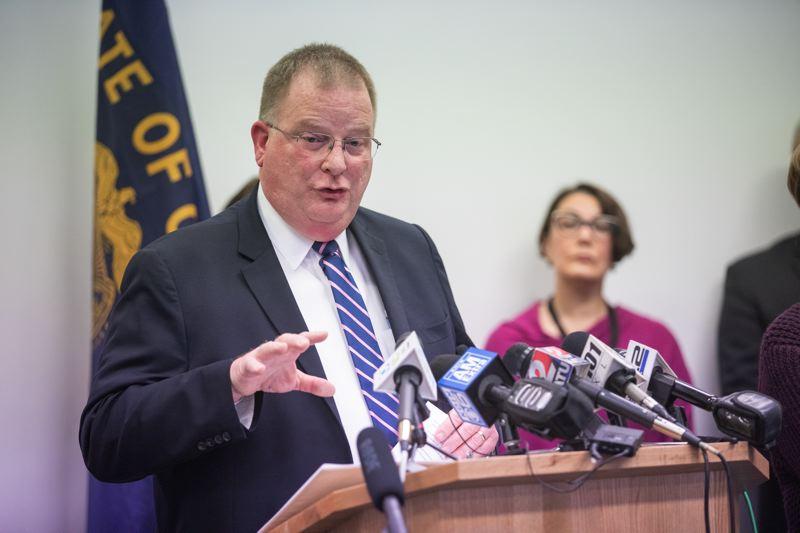
Gov. Kate Brown has repeatedly said her phased plan for reopening counties would be based on data. But her decision to allow Multnomah County to move to Phase 1 on Friday was based partly on misinformation.
The Oregon Health Authority gave her the wrong data.
Director Patrick Allen said Thursday his agency reported that hospitalizations linked to COVID-19 in Multnomah County had stayed the same. Instead, last week hospitalizations jumped from nine to 14. The county has had 29 hospitalizations in the last two weeks.
The mistake marks a high-profile misstep in the authority’s handling of COVID-19 data. The agency has been under scrutiny in the media over its reluctance to be fully transparent about the data.
“We made an error,” Allen told reporters on Thursday. “The data we pulled from our public health database were incomplete and therefore wrong and I apologize for this inaccuracy.”
His admission came a day after Gov. Kate Brown announced that Multnomah County could start lifting restrictions on Friday.
Nevertheless, Brown said she would stick to her decision to let business owners in Multnomah County open restaurants and bars provided strangers can stay 6-feet apart. Personal services like barbershops, hair salons, gyms and spas can open by appointment, and gatherings up to 25 people are permitted.
To move to Phase 1, Brown said counties had to have a decline in virus-related hospitalizations over 14 days, a low percentage of emergency room visits with flu-like symptoms and adequate testing and contact tracing resources.
Phase 2 allows larger gatherings provided individuals, couples or groups that are together have plenty of space and it opens the door for bowling alleys and movie theaters to open. Phase 3 will allow gatherings in large venues, but a vaccine or cure will be necessary before that happens.
Allen said he reported the error quickly.
“Yesterday evening, I was advised that the information the Oregon Health Authority had reported about hospitalizations not increasing in Multnomah County was wrong,” Allen said. “In fact, five more Multnomah County residents had been hospitalized over three days at the end of last week than we originally documented. While this number was a smaller decrease than we expected, we were also concerned these new cases came at the end of the week representing a small uptick we needed to flag.”
Allen said the mistake happened during the authority’s process of manually pulling data from its database, adding that the “team has worked at breakneck pace for many months.” In the future, two analysts will pull data and validate it, Allen said.
“While I regret our mistake, I want you to know that we will always be upfront and open when we make one,” Allen said.
Allen said the authority stands by its original recommendation to reopen Multnomah County despite the slight uptick in hospitalizations. For example, the percentage of visits to hospital emergency rooms due to COVID-19 symptoms is low, Allen said. The rate is 0.6% statewide, or six out of 1,000 visits to emergency departments.
The county continues to have a low rate of positive tests, and the metro region has plenty of empty hospital beds and ventilators, Allen said.
However, some health care advocates warn that Oregon is reopening certain areas of the state too soon. Numi Lee Griffith, patient health care advocate for the Oregon State Public Interest Research Group, known as OSPIRG, said the state’s actions are a “mixed bag” -- the mandate for masks is good, but the move to open Multnomah County is too soon.
Griffith said Multnomah County doesn’t meet the criteria for reopening in Brown’s original plan in April. Hospitalizations in Multnomah county are on an upward trend for June 1 through June 14, state public health indicator data show. That fact is even posted on the agency’s website, which says Multnomah County has “not met” the hospitalization criteria.
“We want to voice the note of caution that if things get out of hand, we will need to reimpose restrictions and people need to be careful,” Griffith said, adding “it’s inconsistent with the original plan we got in April.”
Brown announced on Wednesday that Oregonians in Multnomah, Washington, Clackamas, Marion, Polk, Lincoln and Hood River counties, among the most populous in the state, will need to wear masks in indoor public places. Lane County, which was not included, has relatively few cases.
The directive has exceptions. People with a medical condition that makes breathing difficult and children the age of 12 are exempt. Brown said her office will issue more detailed guidance in the next few days.
It’s unclear how the state will enforce Brown’s order. Brown said her executive order, like any other, is enforceable by law. However, Brown said people won’t “get arrested or get a ticket for not wearing a face covering.”
For weeks, Brown and other public health officials have encouraged Oregonians to voluntarily wear masks in public to slow the spread. Brown said she is “encouraging cajoling, and asking” Oregonians to wear masks.
The directive gives stores and other businesses the authority to ask unmasked customers to leave.
The masks do not have to be medical grade, Brown said. They can be hand-sewn or a bandana-style covering.
“I wear it because I don’t want to accidentally kill someone,” Brown said. “It’s really that simple.”
Other counties will advance in reopening Friday. Marion, Polk and Hood River counties will move to Phase 2 on Friday because those counties have a decline in hospitalizations.
You can reach Ben Botkin at [email protected] or via Twitter @BenBotkin1.
